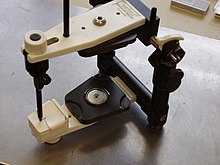Articulator
This article needs additional citations for verification. (December 2009) |


An articulator is a mechanical device used in dentistry to which casts of the maxillary (upper) and mandibular (lower) teeth are fixed, reproducing recorded positions of the mandible in relation to the maxilla. An articulator assists in the fabrication of removable prosthodontic appliances (dentures), fixed prosthodontic restorations (crowns, bridges, inlays and onlays) and orthodontic appliances.
Types
Semi-adjustable articulator
An articulator which is adjustable in one or more, but not all of the following areas: condylar angle, Bennett side-shift, incisal and cuspid guidance, and shape of the glenoid fossae and eminintiae. By nature, this sort of articulator's use is only meaningful if the position of the maxillae are duplicated with respect to the hinge axis of the mandibular condyles.The majority of these articulators again have straight condylar paths, however the path angle may be changed, allowing the patient’s condylar angle to be programmed into the articulator . This is still not a true representation of the articular eminence as it is a flat condylar pathway. Some semi-adjustable articulators have average value Bennett shift/movement built into the condylar head element, replicating the average head shape of the condyle . This mimics the movement of the condyles better than some ball-shaped condylar heads found on other articulators Normally this is achieved by the use of a face-bow.
Fully Adjustable Articulator
A full adjustable articulator is used to reproduce more than one type of movement. It has a centric relationship, protrusive and retrusive movement and it has a left-right lateral maxillomandibular relationship
Anatomical articulator
An articulator which attempts to reproduce normal mandibular movements during mastication.
Adjustable articulator
An articulator that can be adjusted to accommodate the many movements and positions of the mandible in relation to the maxilla as recorded in the mouth.
Disposable articulators
Stone Base – An articulator system in which a model of the patient’s teeth for the maxilla and mandible are each mounted on a stone base with the use of dowel pins. The two are then brought together and articulated using a disposable articulator to act as the condyle. This requires having to make two pours. The first one is to get the model from the impression taken by the dentist. The other pour is for the stone base made from a rubber mold.
Single-Pour - The single-pour system eliminates the need for a stone base. When the impression is poured up, it is directly mounted on a plastic base or tray that already has a built-in condyle to form a complete articulator when the two halves are joined. By eliminating the need to pour up a stone base, the single-pour is a much faster system than the Stone Base system. There are varieties of single-pour systems that use dowel pins, and there are some that omit the need for dowel pins by creating the model completely out of die stone.
Dental articulator 1840-1912
In 1840 the first US patent for dental articulators were issued to two Philadelphia, Pa dentist: James Cameron, and Daniley T. Evens.[1] One glaring weakness that became evident shortly after its release was its inability to manage mandibular movement. Through the 1850s and 60's dental scientist investigated the nature of mandibular movement. By the 1900s the single hinge dental articulators became commonplace. It wasn't until 1910 that dentistry had its first articulator breakthrough due to the work of scientist like W.E. Walker, Alfred Gysi and George Snow. From their work two major schools of articulators developed. On one side there was the new condylar (anatomic)movement and on the other side there was the geometric (non anatomic) movement. The debate between anatomic and non anatomic is demonstrated in this article for an articulator that boasted a simple design.[2] Dr. Rudolph L. Hanau is credited with developing Hanau articulator in 1920s.
Modern day articulator
Through modern day plastics dental articulators like the Spin NEO offer strength and mandibular mobility.[3] Stone enhancers and quick drying materials have dramatically increased the effectiveness of dental articulators. Plastics have the ability to mimic natural mandibular movement because of its strength.
References
- ^ Stracke, Edgar (March 2000). "The History of Articulators: Early Attempts to Reproduce Mandibular Movement" (PDF). Journal of Prothodonist. 9 (1). Retrieved 1 April 2011.
- ^ Stracke, Edgar (June 2002). "A Critical History of Articulators Based on Geometric Theories of Mandibular Movement: Part 1" (PDF). Journal of Prothodonist. 11 (2): 135–136. Retrieved 1 April 2011.
- ^ Balleza, Santy. "Cbite Dental Articulator". 208-695-9554. Retrieved 1 April 2011.
Techniques in Complete Denture Technology Tony Johnson PhD, MMedSci, LCGI, MCGI, FETC, FHEA Senior Lecturer Academic Unit of Restorative Dentistry School of Clinical Dentistry University of Sheffield UK Duncan J. Wood BMedSci, PhD, FHEA Senior University Teacher Academic Unit of Restorative Dentistry School of Clinical Dentistry University of Sheffield UK
